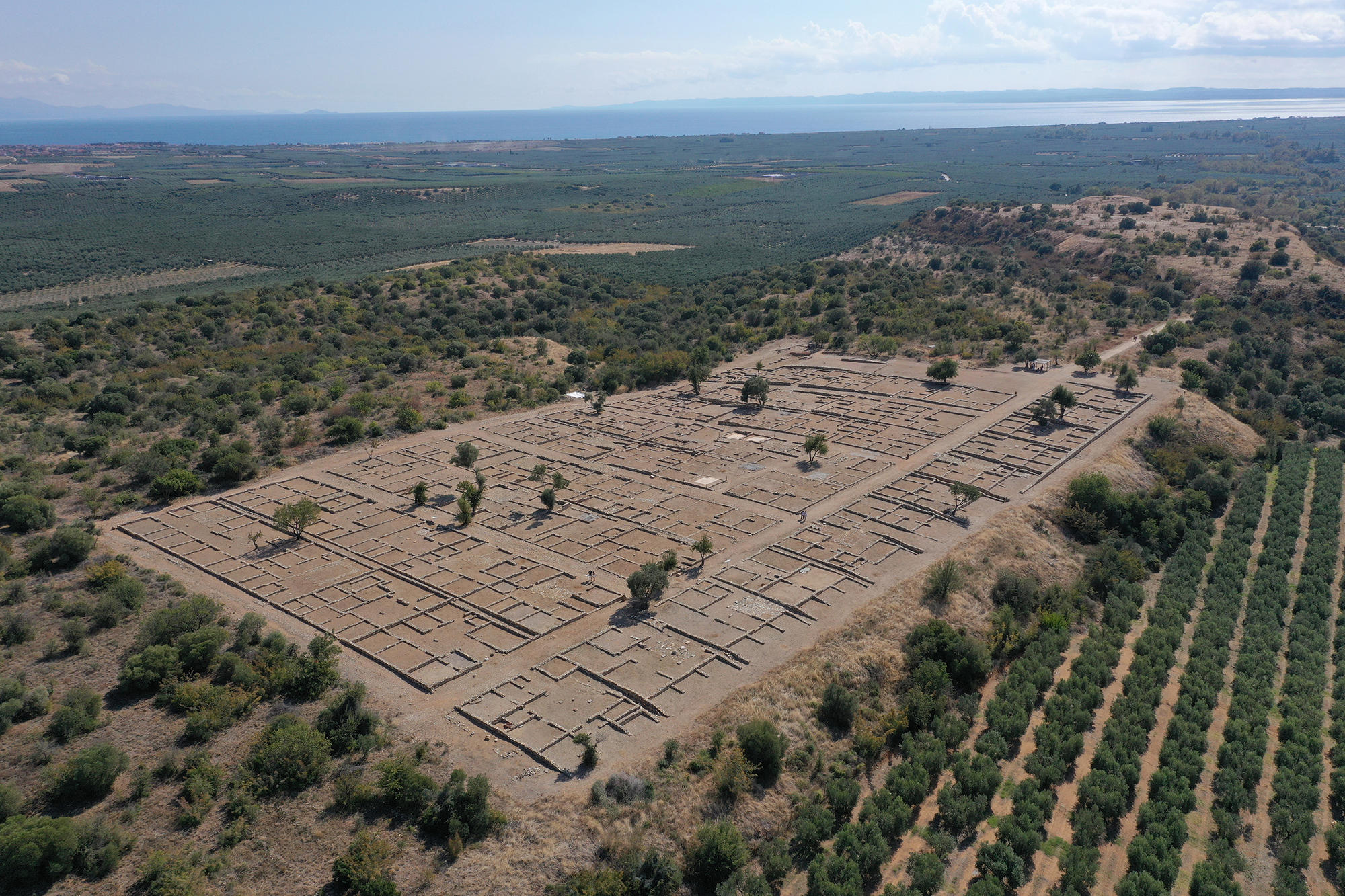
Η αρχαία Όλυνθος, στα ανατολικά του σημερινού χωριού, κτισμένη σε δύο φυσικούς λόφους που δεσπόζουν στην περιοχή, εξελίχθηκε στη σπουδαιότερη πόλη της Χαλκιδικής. Από το 432 π.Χ., όταν εγκαταστάθηκαν εκεί κάτοικοι πολλών παραθαλάσσιων πόλεων και η Όλυνθος έγινε πρωτεύουσα της Χαλκιδικής Συμμαχίας, αποτελούσε το σημαντικότερο οικονομικό-στρατιωτικό κέντρο της περιοχής έως την καταστροφή της από τον Φίλιππο Β΄ το 348 π.Χ. Χάρη στη συστηματική ανασκαφική έρευνα της πόλης και τον εντοπισμό μεγάλου μέρους της, κτισμένη σε οικοδομικά τετράγωνα με το ιπποδάμειο πολεοδομικό σύστημα και επιμελημένο σύστημα ύδρευσης, εμπλουτίστηκαν οι γνώσεις μας για την καθημερινή ζωή των ύστερων κλασικών χρόνων.
The ancient city of Olynthus extends over two natural hills east of the present-day village. There was a settlement of the Late Neolithic period (5300-4500 BC) in the region, one of the first to be excavated in Macedonia that produced significant finds. When the Bottiaeans of Imathia were expelled from their land by the Macedonians in the 7th century BC, they settled on the South Hill and founded the city of Olynthus, whose pre-Greek name derives from the wild fig. This city was destroyed in 479 BC by the Persians, on their return to Asia after their defeat at Plataea. Its inhabitants were massacred and the city was almost entirely destroyed and surrendered to the Chalcidians.
After the Persian Wars, Olynthus became a member of the early Delian League, from which it seceded in 440 BC, to develop into the most populous and wealthy city of Chalkidiki a little later, at the time of its synoecism: in 432 BC, the Macedonian king Perdiccas II convinced the citizens of several seaside cities to abandon the Delian League and settle in Olynthus. The city experienced great prosperity, engaged in commercial activities with Ionia and Athens, and became the capital of the “Chalcidian League”. But the rapid growth of Olynthus brought it into conflict with the Macedonian king Philip II, who could not tolerate another great power in the area; he swept through the city, razed it to the ground after which the city practically disappeared from history.
Excavations at Olynthos under the auspices of the American School of Classical Studies, Johns Hopkins University and under the direction of Professor David M. Robinson, revealed important remains of the city and a large number of finds that provide insight into the daily life and activities of its people. In addition, the “Olynthos Project”, which has been carried out in recent years, in collaboration with the British School of Athens and the Ministry of Culture, aims at a clearer understanding of the entire city, its physiognomy and its special characteristics.
Houses with stone foundations, earthen flooring, brick walls and thatched roofs have been uncovered at the prehistoric settlement of the Neolithic period on the southern part of the hill; a number of finds, such as pottery, stone and clay figurines, as well as weaving tools, provide valuable insight into what daily life was like in the settlement.
Remains of the archaic city were found on the South Hill, where the agora, the bouleuterion, shops and residences were excavated.
The classical city, built based on the Hippodamian system, spreads out on the North Hill: long avenues and smaller vertical streets formed blocks (5-7m wide) consisting of ten houses each. Many of the houses were two-storeyed. The rooms of the house were organized around a central stone-paved courtyard: areas for accommodation and daily household activities, as well as the andron, a banquet hall decorated with mosaic floors in some cases, perhaps the oldest in Greece. The city was laid out with cobbled carriage roads, sidewalks and an integrated water supply system. The newest section extends over the southeastern part of the city, outside the walls; it was built after 379 BC, with luxurious residences, decorated with impressive mosaics. Outside the city, parts of its three cemeteries were excavated, where numerous and significant finds came to light.
Winter hours:
08:30-15:30 November 1st to March 31st
Summer hours:
08:30-15:30 April 1st to October 31st
Closed on Tuesdays
Με αυτοκίνητο ή με ΚΤΕΛ του
νομού Χαλκιδικής μέχρι την
κοινότητα Ολυμπιάδας.
προβολή σε χάρτη
Admission fee standard: 4€
Admission fee reduced: 2€
Address: Konstantinoupoleos 5,
631 00 Polygyros Halkidiki
Phone: +30 23710 22060
Fax: +30 2310 251892
Mount Athos Technical Office
Address: 7 Hippodrome Square, Thessaloniki
Phone: +30 2310 285163
Fax: +30 2310 251892
E-mail: [email protected]
